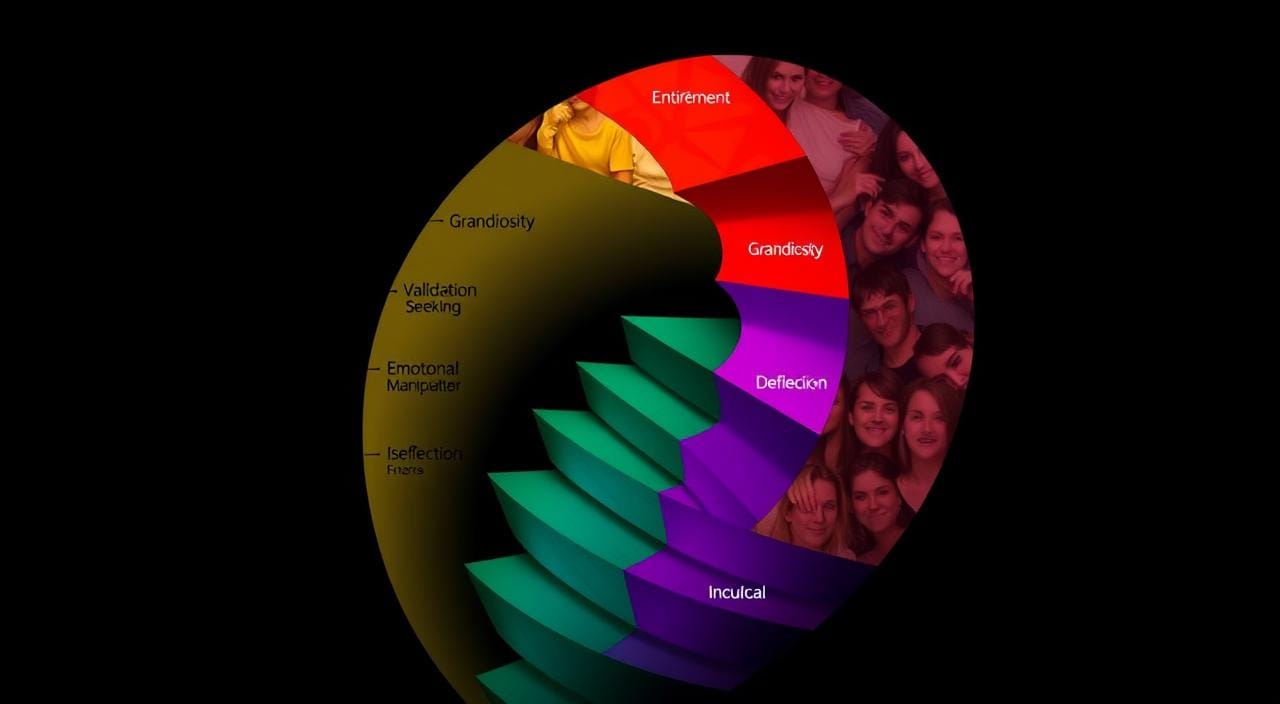I’ve been through the pain of narcissistic abuse. It fills you with fear and doubt when a narcissist tries to pull you back. Narcissists are masters at playing with your. They use many tricks to keep control and get all the praise and attention they want1. They don’t care about hurting you, showing no remorse or feeling for your pain1.
Hoovering is a sneaky way narcissists keep you in their grasp when they think they’re losing you1. They might call or text a lot, use friends to get to you, or even pretend to be worried or desperate1. Their aim is to pull you back, regain control, and keep getting the narcissistic supply they need. Learn about Narcissist Hoovering Examples
Key Takeaways
- Narcissists use hoovering tactics to maintain control and manipulate their victims
- Hoovering can take many forms, from love bombing to emotional blackmail
- Recognizing the signs of hoovering is crucial to protecting yourself from further abuse
- Setting boundaries and seeking support are essential in breaking free from the narcissist’s grasp
- Therapy can help you heal and develop the tools to resist narcissistic manipulation
We’ll look into hoovering, why narcissists do it, and their common tricks. Knowing this can help us protect ourselves and our loved ones from narcissistic abuse.
What is Hoovering?
Understanding the Narcissist’s Manipulative Tactics
Hoovering is a way narcissists try to get their victims back into a bad relationship2. They do this because they fear being left alone and need constant praise, or narcissistic supply2. Hoovering is a way for narcissists to start the cycle of abuse again3.
The term “hoovering” refers to tactics used to pull people back into bad relationships, often seen in narcissistic personality traits4. These tactics include gaslighting, love bombing, giving gifts, and. These actions make the victim feel guilty, confused, or dependent4.
Narcissists who hoover feel entitled, need control, and don’t take responsibility in their relationships2. They use emotional abuse to avoid being left by their source of narcissistic supply2. It’s important to know the signs of hoovering and set clear boundaries to protect yourself2.
“Hoovering is a toxic pattern of idealization, devaluation, and discardment within relationships, often employed by those with narcissistic, borderline, anti-social, or histrionic personality disorders.”3
Why Do Narcissists Hoover?
Narcissists crave narcissistic supply – constant praise, attention, and admiration. When they lose access to this, they feel threatened. They try to “hoover” the person back into their life5.
This is because they are emotionally dependent on the victim. They want to regain control in the narcissistic abuse cycle5.
Narcissists often keep their ex-partners in their lives for years5. They use tactics like excessive flattery, apologies, and gifts to lure them back6. These actions make the victim feel special and needed again6.
Responding to a narcissist’s hoovering can make things worse5. But cutting off contact can bring relief and peace5.
Narcissists hoover because they crave control and can’t form real connections. Knowing this helps us protect ourselves. It keeps us safe from falling back into their trap6.
“Hoovering is a common narcissistic manipulation tactic used to suck people back into a relationship, even after a narcissist has discarded or abandoned them.”
Narcissist Hoovering Examples
Hoovering is a manipulative tactic used by narcissists after you leave. Suddenly and without warning, they may contact you through various means. These messages often highlight the good times in your past relationship, trying to draw you back in7.
Narcissists use many tactics to hoover, not just sentimental messages7. They might make dramatic declarations of love, make accusations, threaten self-harm, or spread fake gossip. Their goal is to pull you back into the toxic relationship, no matter the cost7.
It’s key to recognize these hoovering tactics to protect yourself7. Experts say knowing these signs helps you stay safe and break free from manipulation7. Understanding the narcissist’s moves helps you focus on your own healing8.
It’s hard to resist a narcissist’s hoovering, but it’s crucial8. Cutting off contact and setting clear boundaries are key to protecting yourself8. By spotting these signs, you can stop the abuse and take back your life8.
“Hoovering is any attempt by a person to pull someone else back into their orbit. It’s a way to get their needs met, even if it’s at the expense of the other person.”
– Kelly Scott, Psychologist
Love Bombing and Idealization
Narcissists use a tactic called “love bombing” to keep their victims in a cycle of abuse. They shower their targets with lots of love and attention early on9. This phase can last from weeks to months, with an average of five-and-a-half months for men and three-and-a-half for women9. The longest reported time is six months9.
The goal is to create a strong emotional bond quickly. This allows the narcissist to control and manipulate their partner9. The victim feels special and valued, drawn to the narcissist10. But, this is just a way to make the victim dependent and boost the narcissist’s self-worth10.
Signs of love bombing include intense affection and deep commitment talks early on. Look out for jealousy, isolation, lavish gifts, and possessiveness9. It’s important to watch your emotional health, as love bombing can harm it9.
Love bombing is often linked to narcissism, but it can also be seen in others10. It’s a manipulation tactic that should not be ignored10.
“Love bombing is a narcissistic approach to relationship formation, where the narcissist showers the target with excessive affection, attention, and gifts in order to gain control and influence over them.”
If you think you’re being love bombed or experiencing narcissistic behavior, seek help from a mental health professional10. They can help you understand and protect your well-being10.
| Narcissistic Behavior | Description |
|---|---|
| Love Bombing | Showering the target with excessive affection, attention, and gifts to gain control and influence. |
| Idealization | Perceiving the target as perfect, flawless, and the solution to all their problems. |
| Manipulation | Using various tactics to exploit and control the target for the narcissist’s own benefit. |
| Narcissistic Abuse | The emotional, psychological, and sometimes physical abuse perpetrated by a narcissist against their partner. |
Gaslighting and Blame-Shifting
Narcissists often use gaslighting to control their victims. Gaslighting tricks the victim into doubting their own memories and feelings11. This makes the victim feel unsure and gives the narcissist power.
Another trick is blame-shifting. The narcissist blames others to make the victim feel guilty11. This keeps the narcissist in charge and avoids their own blame.
- Narcissists go through cycles of being sweet and mean, making their victims feel loved and then worthless11.
- Studies show narcissists and psychopaths use blame-shifting and gaslighting in arguments12.
- They also create jealousy by setting up love triangles to keep their victims hooked12.
It’s important to know these tricks to protect yourself from narcissistic abuse. Understanding gaslighting and blame-shifting helps you stay safe. Click here to learn more about codependent narcissists and how to protect yourself.
“Narcissists often use seasonal devalue and discard during holidays to abuse their partners, ruining special times.”12
| Manipulation Tactic | Description |
|---|---|
| Gaslighting | Misrepresenting an event to convince the victim they are wrong and cannot trust their own senses, memories, and experiences. |
| Blame-Shifting | Making accusations to provoke the victim into feeling guilty and defensively explaining themselves. |
| Triangulation | Inciting jealousy and competition through love triangles to keep the victim engaged and dependent. |
| Sleep Deprivation | Used as a control tactic to keep the victim tired and weak. |
| Stonewalling and Silent Treatment | These tactics can cause psychological pain similar to physical harm. |
Knowing these tricks helps us protect ourselves from narcissistic abuse1112.
Creating Crises and Emergencies
Narcissists are experts at playing with our emotions to pull us back into their toxic world. They often create crises or emergencies to get our sympathy and worry13. They might call us in the middle of the night, saying they have a health issue or a family problem, and they really need our help. The situation seems so urgent and serious that it’s hard to say no, and that’s exactly what they want.
But these emergencies are usually made up or blown out of proportion. It’s a way for them to get us back into the relationship and keep the abuse going14. They might even threaten to harm themselves or use other tricks like love bombing or future faking to make us help them14. This emotional trickery is how they keep control and power over us.
It’s key to see through these tricks and not fall into their trap14. Getting help from mental health experts, support groups, or friends we trust can help us escape the abuse cycle and protect ourselves14. By staying strong and focusing on our own well-being, we can break free from the narcissist’s hold and start living a better life.
“Narcissists often create crises or emergencies to manipulate our emotions and draw us back into their toxic web. Recognizing these tactics and seeking support are crucial to breaking free.”
- Narcissists may use manipulation tactics such as sending unsolicited messages, performing apologies, or declaring love to draw individuals back into toxic relationships13.
- Manipulative ex-partners might capitalize on important dates or seasons like holidays or birthdays to reconnect13.
- Techniques may involve pretending to have undergone changes, showering the victim with gifts, or making promises they have no intention of keeping13.
- Beware of threats to self-harm as a form of emotional manipulation by the person attempting hoovering13.
- Additional signs include spreading false gossip, using intermediaries to reach out to the victim, or acting as if previous conflicts never occurred13.
By understanding these tactics and focusing on our own well-being, we can escape the narcissist’s grasp and start a healthier, more fulfilling life14. Recognizing the patterns of behavior in narcissistic relationships, like Hoovering and Future Faking, is crucial to protect ourselves and break free from the abuse cycle14.
Triangulation and Smear Campaigns
Narcissists often use tactics like triangulation and smear campaigns to control and seek validation15. They might spread rumors or make false accusations when they face rejection or boundaries15. This is because they need to control the narrative and maintain their image15.
Triangulation involves bringing others into your relationships to disrupt them15. Narcissists use social media to make these tactics worse, including emotional abuse and manipulation15. They might even make false claims to employers or family members15.
Narcissists use these tactics to protect their self-worth and avoid feeling rejected15. It’s best not to engage with them, as it can make things worse15. Focus on what you can control and ignore their attempts to manipulate15.
Narcissists often pretend to be victims when confronted, distorting the truth to get sympathy16. They have a pattern of idealizing, devaluing, and discarding others, showing a lack of tolerance for ambiguity16.
Dealing with a narcissist can be tough, but knowing their tactics can help you regain control1516.
Intermittent Reinforcement
Narcissists are skilled manipulators. They use intermittent reinforcement to create a strong bond with their victims17. This tactic involves giving rewards like affection or attention at random times. It’s hard for victims to escape this cycle of abuse17.
Intermittent reinforcement works by making rewards unpredictable18. This makes the brain release dopamine, creating an addiction-like feeling18. Victims stay hopeful, always looking for the next validation from their abuser.
Narcissists use love-bombing, devaluation, and discard to control their victims18. Their unpredictable behavior erodes the victim’s self-esteem and freedom18. Even small acts of kindness can strengthen the bond17.
It’s important to understand the power of intermittent reinforcement for those abused by narcissists18. Recognizing the patterns helps victims see through the narcissist’s tricks. They can then take back control and break free from the abuse18.
The Cycle of Abuse and Reinforcement
Trauma bonding forms in abusive relationships, making it hard to leave17. It’s fueled by power imbalance, unpredictable affection and abuse, and intense emotional bonding17.
Victims often see small acts of kindness as positive, strengthening the bond17. The dopamine rush from intermittent reinforcement makes the bond intense and hard to break17.
| Trauma Bonding Indicators | Description |
|---|---|
| Self-blame | Victims taking responsibility for the abuser’s actions |
| Seeking Abuser’s Approval | Desperate attempts to gain the abuser’s validation and affection |
| Defending the Abuser | Protecting the abuser and minimizing their harmful behavior |
| Self-Harm | Engaging in behaviors that cause physical or emotional harm to oneself |
| Adjusting Behaviors | Modifying actions to meet the abuser’s changing expectations |
The cycle of abuse and reinforcement keeps narcissists in control17. Understanding this and the science behind it helps victims recognize abuse. They can then take steps to regain their power and break free18.
Protecting Yourself from Hoovering
First, we must recognize hoovering as a manipulative tactic used by narcissists19. Hoovering is when a narcissist tries to reconnect after being apart. They do this because they need constant emotional validation and attention to keep up their False Self19. This behavior is part of a cycle of violence, with narcissists showing no real remorse or accountability19.
Setting Boundaries and Seeking Support
To shield ourselves from narcissistic hoovering, setting clear boundaries and seeking help are key20. Gaslighting, a common emotional abuse tactic, can make us feel confused, anxious, and drained20. Therapy and recovery coaching are crucial for healing, helping us understand the narcissist’s manipulative ways and find ways to cope20.
Strategies for coping include talking to a therapist or coach, joining support groups, and practicing self-care20. Healing from narcissistic abuse is a long journey that needs patience and determination. But with the right support, we can find our sense of self and escape the cycle of manipulation20.
“Hoovering is not about love but serves as a means for the narcissist to emotionally survive.”19
- Recognize hoovering as a manipulative tactic used by narcissists19.
- Set firm boundaries to protect yourself from emotional abuse20.
- Seek professional support, such as therapy or recovery coaching, to understand and heal from narcissistic abuse20.
- Engage in self-care activities and join support groups to cope with the emotional impact20.
- Understand that healing from narcissistic abuse is a process that requires patience and perseverance20.
By taking these steps, we can break free from narcissistic manipulation and regain our power20. Protecting ourselves from hoovering is vital for our emotional health. With the right support, we can move towards a healthier, more fulfilling life20.
Check out the detailed guide on [how to expose a narcissist online](https://narcissismexposed.com/how-to-expose-a-narcissist-online/) to learn more about narcissistic tactics and how to protect yourself.
Conclusion
Hoovering is a tactic used by narcissists to pull victims back into toxic relationships2. They use love bombing, gaslighting, and creating crises to control their victims2. It’s important to recognize these signs and set boundaries to protect ourselves212.
Victims of narcissistic abuse often try to leave seven times before they succeed21. Even after escaping, they face continued attempts to lure them back21. Narcissists use promises and guilt to try to win them back21. It’s crucial to stay alert to these tactics to avoid falling back into harm21.
Getting help from a therapist or coach can be a big step towards healing22. Understanding narcissistic behavior helps us build emotional strength22. This way, we can overcome these challenges and take back our lives22.
FAQ
What is hoovering?
Hoovering is a way narcissists keep their victims in a bad relationship. They use tactics like love bombing and gaslighting. They also create crises and use rewards to keep the victim coming back.
Why do narcissists hoover?
Narcissists fear being alone without someone to blame and admire them. They use hoovering to keep control and get the attention they crave.
What are some common narcissist hoovering tactics?
Narcissists might say they love you a lot, accuse you, or threaten to harm themselves. They also call or text randomly, spread rumors, make big promises, and create fake emergencies.
How do narcissists use love bombing and idealization in hoovering?
Narcissists shower their victims with love and admiration to pull them back. This tactic is used to keep the victim in a bad relationship.
How do narcissists use gaslighting and blame-shifting in hoovering?
Narcissists lie to make you doubt yourself. They also blame you to make you feel guilty. This gives them power over you.
How do narcissists use crises and emergencies to hoover?
Narcissists might call in the middle of the night with a fake crisis. They do this to get you to come back and keep the abuse going.
How do narcissists use triangulation and smear campaigns in hoovering?
Narcissists spread rumors to hurt your reputation and relationships. This makes it hard for you to leave the relationship.
How do narcissists use intermittent reinforcement in hoovering?
Narcissists give rewards at random to keep you hooked. This creates a strong bond and makes it hard to leave.
How can you protect yourself from narcissist hoovering?
Set firm boundaries and avoid the narcissist. If worried about their mental health, call the authorities. Getting help from a therapist or coach can help you break free and regain your self-worth.
Source Links
- Spotting the Hoovering Techniques of a Narcissist – https://www.psychologytoday.com/us/blog/addiction-and-recovery/202105/spotting-the-hoovering-techniques-narcissist
- The Manipulative Tactics of Narcissists: Hoovering Explained – https://www.verywellmind.com/narcissistic-hoovering-8407338
- Getting This Kind Of Text From Your Ex Is A Big Red Flag – https://www.mindbodygreen.com/articles/hoovering-in-relationships
- Hoovering: Definition, Signs, and Coping Tips – https://psychcentral.com/relationships/hoovering
- 7 Facts to Know About Narcissistic “Hoovering” – https://www.psychologytoday.com/us/blog/here-there-and-everywhere/202209/7-facts-know-about-narcissistic-hoovering
- 17 Narcissist Hoovering Examples to Understand the Behavior – https://www.marriage.com/advice/mental-health/narcissist-hoovering-examples/
- Hoovering Narcissist: Definition, Examples, & How to Respond – https://www.wikihow.com/Hoovering-Narcissist
- Everything To Know About The Manipulation Tactic Narcissists Use To Win Back Their Exes – https://www.bustle.com/wellness/hoovering-examples-narcissists
- Narcissistic Love Bombing Cycle: Idealize, Devalue, Discard – https://www.simplypsychology.org/narcissistic-love-bombing-cycle.html
- What Is Love Bombing and Why Do Narcissists Do It? – https://psychcentral.com/disorders/narcissistic-personality-disorder-love-bombing
- Hoovering | How Narcissists Try to Suck You Back In – https://medium.com/@OwnYourReality/hoovering-how-narcissists-try-to-suck-you-back-in-fe46bc380c2c
- 5 Terrifying Ways Narcissists and Psychopaths Manufacture Chaos and Provoke You – https://psychcentral.com/blog/recovering-narcissist/2019/10/5-terrifying-ways-narcissists-and-psychopaths-manufacture-chaos-provoke-and-manipulate-you
- 12 Signs You’re Being Hoovered By a Narcissist – https://www.healthline.com/health/hoovering
- Understanding The Narcissist Can Set You Free — Jessica Anne Pressler .lcsw – https://www.jessicaannepressler.com/blog/blog-series-part-5-future-faking-gray-rock-and-hoovering
- Dealing with the Narcissist’s Smear Campaign – https://www.psychologytoday.com/us/blog/tech-support/201906/dealing-the-narcissists-smear-campaign
- How the narcissist hooks you: Hoovering & baiting – https://narcwise.com/2019/01/20/narcissist-hooks-hoovering-baiting/
- Narcissists Use Trauma Bonding and Intermittent Reinforcement To Get You Addicted To Them: Why Abuse Survivors Stay – https://psychcentral.com/blog/recovering-narcissist/2019/03/narcissists-use-trauma-bonding-and-intermittent-reinforcement-to-get-you-addicted-to-them-why-abuse-survivors-stay
- Intermittent Reinforcement: Tactic Used By Narcissists to Keep Victims Under Their Spell – https://www.randifine.com/post/intermittent-reinforcement-why-it-keeps-us-coming-back-for-more
- Hoovering – How The Narcissist Tricks You Into Breaking No Contact – https://blog.melanietoniaevans.com/hoovering-how-the-narcissist-tricks-you-into-breaking-no-contact/
- Narcissistic Hoovering: How to Stop the Emotional Rollercoaster – https://www.narcissisticabuserehab.com/narcissistic-hoovering/
- Narcissistic Hoovering Techniques to Watch Out For – Narcissistic Behavior – https://narcissisticbehavior.net/narcissistic-hoovering/
- Understanding Narcissistic Relationships: The Cycle of Love Bombing, Devaluation, and Hoovering – https://www.drmazzella.com/narcissistic-relationships-the-cycle-of-love-bombing-devaluation-and-hoovering/












